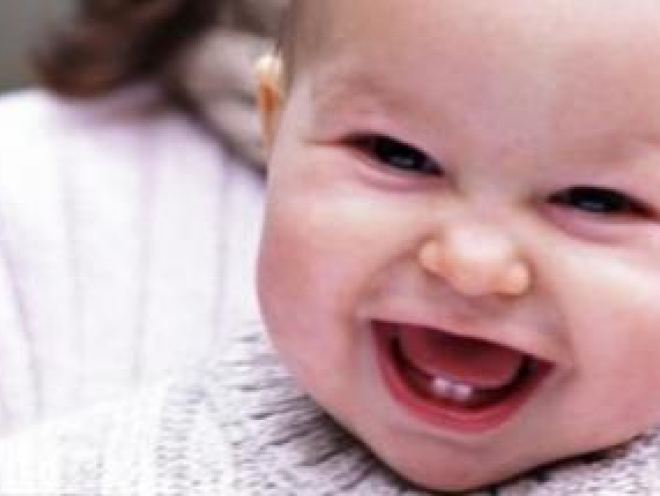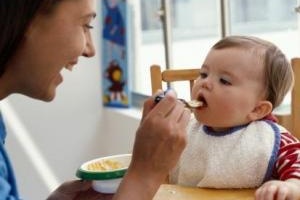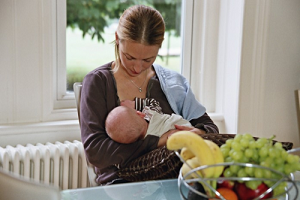Teething signs can be confusing, and you’ll hear so many myths. Here we explore what teething is exactly and the signs you'll see.
Teething happens at the same time as babies are vulnerable to illnesses and ailments as their immune system develops (Simon et al, 2015). This has led to confusion around what’s a sign of teething, and what’s not. Not just among parents but also some healthcare professionals (Plutzer et al, 2012; Eisenstadt et al, 2017).
This article sets out the signs and symptoms widely agreed to be caused by teething. It also flags up signs and symptoms not caused by teething that you’ll need to go and see your doctor about.
But first, the basics: What exactly is teething?
Teething is usually defined as when your baby’s teeth start to emerge through their gums (NHS, 2019). Their teeth were always there, within the jawbones, when they were born (Lyttle et al, 2015; NICE, 2020).
"Some babies are born with their first teeth. Others start teething before they are four months old, and some after 12 months. But most babies start teething at around six months (NHS, 2019)."
Your baby’s complete set of first teeth is usually on show by the time they’re three years old (NICE, 2020). These are often known as baby teeth or milk teeth, though the medical term is deciduous teeth because they will later fall out (NICE, 2020).
Even though your baby's first teeth will fall out, they are very important for your baby’s health. This is because they help your child with eating solids and speech development, as well as self-esteem (Waite, 2019).
For a full guide to which teeth appear and when, see our month-by-month teething article.
Teething: What are the signs?
A baby’s teeth sometimes appear with no pain or discomfort at all (NHS, 2019). But others experience a constant, dull pain that gets increasingly intense in the four days before a tooth can be seen, before improving rapidly (Lyttle et al, 2015).
Your baby can’t use words to say they are in pain but you might see some pretty obvious signs there is a tooth on its way. The signs widely agreed to be sure indicators of teething include:
- drool, and lots of it – teething babies can dribble way more than usual
- them biting and gumming down on anything and everything – that’s because the gnawing and chewing provides them with relief
- them being more grumpy, distressed and irritable than usual
- sore and red gums
- a loss of appetite.
(Lyttle et al, 2015; Eisenstadt et al, 2017; NHS, 2019)
Other symptoms that might be signs of teething (although there is some debate over these) include:
- gum-rubbing
- sucking
- wakefulness
- ear-rubbing
- facial rash
- a runny nose
- a mildly-raised temperature, but still under 38°C, might also be a sign.
(Eisenstadt et al, 2017; NICE, 2020)
Your baby might be showing one of these signs or symptoms, or all of them. As with everything baby related, no two little ones are the same (Lyttle et al, 2015). In fact, teething signs can be so wide ranging, and vary so much from baby to baby that only one third of teething infants would experience any one of the signs above (Macknin et al, 2000).
Some studies go as far as to say none of these symptoms can be proven to be a sign of teething. They suggest the only way to know if your baby is teething is to examine their mouth – looking and feeling for an emerging tooth (Tighe and Roe, 2007).
Try laying your baby on your lap and sneaking a peek inside their mouth by moving their top or bottom lip or gently coaxing open their jaw. Use a clean finger to gently feel around their upper and lower gums systematically, one potential tooth spot at a time.
Is my baby teething or sick?
What’s not teething?
Other signs and symptoms that studies have found are generally NOT linked with teething include:
- congestion and coughs
- sleep disturbance
- runny poos, increased number of poos and nappy rash associated with them
- less interest or appetite for liquids
- rashes other than facial rashes
- fever over 38°C
- vomiting.
(Eisenstadt et al, 2017; NICE, 2020)
It’s important you don’t assume one of these is a sign of teething. It could be something more serious and require medical attention.
Don’t confuse illness with teething
A fever and other clinically important symptoms, like diarrhoea, vomiting and rashes are very unlikely to be caused by teething, so make sure you talk to your GP or call NHS 111 (Tighe and Roe, 2007).
One study looked at 50 babies admitted to hospital with various conditions which the parents mistook for teething. In 48 of these children, a medical condition other than teething was identified, including a case of bacterial meningitis (Tighe and Roe, 2007).
Right, I’ve established my baby is teething. Now what?
You can read our articles on how to ease the pain associated with teething, and top tips proven to work.
It is also important to look after yourself, as your baby’s upset is likely to be stressful. You might feel exhausted too, as they’ll require even more of your attention. Our keeping calm with a crying baby article has some useful techniques you can try to keep your stress levels down.
This page was last reviewed in July 2022.
Further information
Understanding the changes your baby is going through will help you to care for them. Our NCT New Baby course gives you the space to focus on your baby’s needs, as well as your own.
If you have any questions or concerns about feeding your baby, our support line offers practical and emotional support. Call 0333 255 3308.
Make friends with other parents-to-be and new parents in your local area for support and friendship by seeing what NCT activities are happening nearby.
Read more about fever in children from the NHS.
For more information on what other illnesses may be causing their fever, this article from NICE is very useful.
If you are concerned, contact your GP or call NHS 111 where you can access urgent medical help fast.
NCT has partnered with the British Red Cross to offer courses in baby first aid.
Eisenstadt M, Malkiel S, Pollak U. (2017) It’s alright, ma (I’m only teething...) dispelling the myth from the teeth. Acad J Ped Neonatol. 3(4):555618. Available at: https://juniperpublishers.com/ajpn/pdf/AJPN.MS.ID.555618.pdf [Accessed 23rd July 2022]
Lyttle C, Stoops F, Welbury R, Wilson N. (2015) Tooth eruption and teething in children. Pharm J. 295:7883. Available at: https://doi.org/10.1211/PJ.2015.20069598
Macknin ML, Piedmonte M, Jacobs J, Skibinski C. (2000) Symptoms associated with infant teething: a prospective study. Pediatrics. 105:747-752. Available at: https://doi.org/10.1542/peds.105.4.747
NHS. (2019) Baby teething symptoms. Available at: https://www.nhs.uk/conditions/baby/babys-development/teething/baby-teet… [Accessed 23rd July 2022]
NICE. (2020) Teething. Available at: https://cks.nice.org.uk/topics/teething/#!diagnosissub:1 [Accessed 23rd July 2022]
Plutzer K, Spencer AJ, Keirse MJ. (2012) How first-time mothers perceive and deal with teething symptoms: a randomized controlled trial. Child Care Health Dev. 38(2):292-299. Available at: https://doi.org/10.1111/j.1365-2214.2011.01215.x
Simon AK, Hollander GA, McMichael A. (2015) Evolution of the immune system in humans from infancy to old age. Proc Biol Sci. 282(1821):20143085. Available at: https://doi.org/10.1098/rspb.2014.3085
Tighe M, Roe MFE. (2007) Does a teething child need serious illness excluding? Arch Dis Child. 92(3):266-268. Available at: https://doi.org/10.1136/adc.2006.110114
Waite C. (2019) Do baby teeth matter? Available at: https://bda.org/news-centre/blog/do-baby-teeth-matter [Accessed 28th September 2022]







